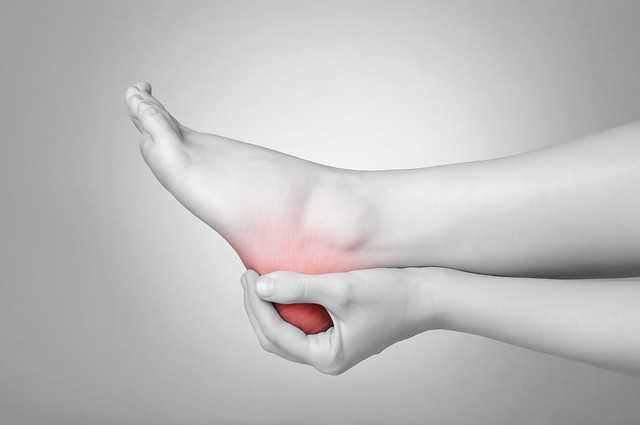Plantar Fasciitis
Plantar fasciitis is one of the most common sorts of heel pain. Your plantar fascia is a strong band of tissue that runs across the bottom of your foot connecting your heel bone to your toes. Plantar fasciitis is sometimes described as an overuse injury, as persistent repetitive stress can damage the tissue, causing pain often on the bottom of your heel or your arch.
Plantar fasciitis can affect anyone, but especially people who have jobs keeping them on their feet much of the time and athletes, such as runners.
Rachel Miller is a highly experienced podiatrist who treats many patients for plantar fasciitis. Please, see below if you want more detailed explanation of plantar fasciitis, its symptoms, causes and treatment.
Contact the Centre for an appointment on 020 8348 5333
Plantar Fasciitis
The purpose of the plantar fascia is to lift the heel off the ground during gait, during walking or running. When the heel lifts the plantar fascia winds around the base of the toes and becomes taut. In some foot types this structure becomes susceptible to injury which can cause a chronic pain condition known as plantar fasciitis. The pain commonly occurs at the medial, the inner part of the heel, but also can occur at any part of the plantar fascia. Plantar fasciitis is a degenerative condition and is also called plantar fasciosis.
Symptoms of plantar fasciitis
You might first notice plantar fasciitis as a pain under your heel or in your foot arch, which is worse first thing in the morning or after resting. This pain can ease with movement, warming up, and as the day goes on the pain tends to get worse again.
Other symptoms can include:
- a stiffness in the heel
- swelling and tenderness on the bottom of the foot
- a sharp burning sensation
If your plantar fasciitis progresses without treatment and your plantar fascia deteriorates, the condition can become painful all the time. Delay in treatment can mean the formation of calcium, bone, within the plantar fascia, which can mean it takes longer to heal.
Causes of plantar fasciitis
Plantar fasciitis is sometimes described as an overuse injury, as persistent repetitive stress can lead to micro trauma in the plantar fascia interfering with healing processes.
A person’s foot mechanics can be a contributing factor in plantar fasciitis. High arches (pes cavus) can cause excessive supination, when to compensate for your high arch your foot rolls further outwards than normal during motion. This can lead to stresses in the plantar fascia. Flat feet (pes planus) can be linked with overpronation, with your foot rolling inwards during gait which can increase the risk of developing plantar fasciitis.
Limited ankle dorsiflexion is also considered to be a factor in developing plantar fasciitis. Your gastrocnemius, one of your calf muscles, can be tight causing an increase in your Achilles tendon tension that can alter your gait, increasing your steps per day. It is thought that this increased force may lead to added stress on your plantar fascia. One study estimates that nearly 4 out of 5 people with plantar fasciitis also have a tight Achilles tendon.
Risk factors for plantar fasciitis include:
- obesity or a sudden weight gain
- flat feet (pes planus)
- high arches (pes cavus)
- limited ankle dorsiflexion
- poor footwear
Plantar fasciitis is most often associated with jumping sports, such as basketball and running sports, especially those that involve toe running rather than heel running styles. Training or competing on hard surfaces can be an aggravating cause and changes to exercise patterns, such as to a more intense regime, may initiate plantar fasciatis. The condition is often found in people wearing the wrong shoes with poor arch support.
Workers who have to remain standing, especially on hard surfaces, can be susceptible to plantar fasciitis.
Other factors can include:
- age; being middle aged or older
- leg length differences
- some medical conditions, such as spondyloarthropathies or diabetes
- being pregnant
- previous injuries, such as ankle sprains
Trauma injuries, such as landing on an object and bruising your plantar fascia, can exacerbate your susceptibility to plantar fasciitis.
Treatment of plantar fasciitis
Plantar Fasciitis has a good rate of recovery. A comprehensive biomechanical assessment from an experienced podiatrist can diagnose plantar fasciitis and the reasons why you might susceptible to the condition. You will then be given a treatment plan which can include:
- self-help advice, such as stretching and strengthening exercises
- advice about your exercise regime, taking into account its intensity and the type of surface you train and compete on
- foot taping
- footwear advice
- rest
- applying ice
- medication advice
- an orthotic insole
A bespoke orthotic insole can be prescribed as part of your treatment plan to help support and stabalise the foot.
Call 020 8348 5553 to make an appointment
Rachel Miller is a highly experienced podiatrist specialising in biomechanics who sees many patients for plantar fasciitis. Her clinic, Highgate Podiatry, is in Highgate Village, 14 Pond Square, N6 6BA, London. Clinics are held every Sunday, Wednesday and Thursday. Please contact the clinic for an appointment on 020 8348 5553. For the clinic’s address, map and directions see the Contact page and for information about orthotic insoles and biomechanics see the Biomechanics page.
Links to Services:
Links to Conditions Treated Include:
- Achilles tendinopathy
- Ankle fractures
- Ankle injuries
- Arthritis
- Back pain
- Bunions
- Corns/Calluses
- Diabetic care
- Flat feet
- Fungal toenail/athlete’s foot
- Haglund’s deformity
- Hammer toe and mallet toe
- Heel pain
- High arches
- Hypermobility
- Ingrown toenail
- In-toeing, toe walking, curly toes
- Knee injuries
- Metatarsalgia
- Morton’s neuroma
- Osgood-Schlatter disease
- Overuse injuries
- Patella tendinopathy
- Patellofemoral pain syndrome
- Plantar fasciitis
- Sever’s disease
- Sprained ankles
- Stress fractures
- Tarsal tunnel syndrome
- Toenails






